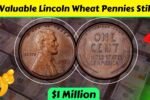Join on WhatsApp
Get the latest updates directly on WhatsApp – motivation, news & more!
Most people think of pennies as small change with little to no value, often tossed aside or left forgotten in jars. Yet hidden among these coins is one of the most fascinating treasures in American history: the Lincoln Wheat Penny. Some rare versions of this coin have shocked collectors by reaching multimillion-dollar valuations, making them a symbol of both wealth and history.
The Lincoln Wheat Penny is more than just currency. It is a reflection of American heritage, commemorating Abraham Lincoln’s centennial in 1909. Over the years, it has become a coin that represents both cultural significance and numismatic rarity.
The Beginning of the Lincoln Wheat Penny
The Lincoln Wheat Penny was first introduced in 1909 to honor the 100th birthday of President Abraham Lincoln. Designed by Victor David Brenner, it broke tradition by featuring the portrait of a real person instead of the symbolic Liberty images used on earlier U.S. coins.
The front of the coin displays Lincoln’s profile, while the back shows two wheat stalks surrounding the words “ONE CENT.” These stalks symbolized the country’s agricultural foundation and economic strength. This wheat design lasted until 1958, when it was replaced with the Lincoln Memorial reverse.
Because of its long production run, billions of wheat pennies were minted, but only a small number hold exceptional value today.
What Makes Some Pennies Worth Millions
Not every wheat penny is valuable. The difference between a common coin and a multimillion-dollar treasure lies in several key factors. Rarity is the most important. Coins with limited production or unusual features attract intense interest from collectors. Historical importance also adds to a coin’s worth, especially if it is tied to special events or minting errors.
Condition plays a crucial role as well. A penny in uncirculated or pristine form can be valued far higher than one that has circulated for decades. Even slight variations such as mint marks or errors can transform an ordinary coin into a priceless find.
The Famous 1943 Copper Penny
World War II created one of the most legendary errors in U.S. coinage. In 1943, the U.S. Mint switched from copper to steel to save copper for the war effort. However, a small number of copper blanks were accidentally used, resulting in the rare 1943 copper penny.
These pennies are considered some of the most valuable coins in American numismatics. Their rarity, historical context, and accidental creation make them highly desirable among collectors.
Other Rare Varieties Collectors Seek
Beyond the 1943 copper penny, there are several other wheat pennies that are highly valuable. The 1909-S VDB penny is one of the most famous. It was produced in limited numbers at the San Francisco Mint and features the designer’s initials before they were briefly removed due to public criticism.
The 1914-D penny from the Denver Mint is another sought-after coin due to its scarcity in good condition. Additionally, the 1922 “No D” penny, created by a minting error that omitted the Denver mark, is a significant rarity. Each of these coins demonstrates how scarcity and uniqueness can drive value.
How to Identify a Valuable Wheat Penny
Collectors look for several details when examining wheat pennies. The date is always the first indicator. Certain years, like 1909 or 1943, immediately raise attention. Mint marks, found just below the date, also matter. An “S” for San Francisco or a “D” for Denver can dramatically affect a coin’s value.
The coin’s composition is another clue. For example, a 1943 penny that appears copper rather than steel deserves closer inspection. A magnet test can confirm its authenticity, since steel pennies are magnetic while copper is not.
Finally, condition is key. Coins with sharp details, original luster, and minimal wear are far more desirable than worn-out versions.
The Hunt for Hidden Treasures
What excites collectors and casual enthusiasts alike is the possibility that valuable wheat pennies may still be in circulation. Many rare coins have been discovered in everyday places, including loose change, inherited coin jars, or even bank rolls.
Stories of people finding rare wheat pennies in ordinary circumstances keep the thrill of discovery alive. Collectors often check every penny they receive, knowing that patience and attention can sometimes lead to incredible finds.
Protecting and Authenticating Rare Finds
If someone believes they have discovered a valuable wheat penny, the first step is preservation. The coin should not be cleaned or polished, as this can ruin its value. Instead, it should be stored carefully in a protective holder.
Professional authentication is essential. Trusted grading services such as the Professional Coin Grading Service (PCGS) and the Numismatic Guaranty Corporation (NGC) can verify authenticity and provide an official grade. These evaluations are vital for insurance, sales, and auctions.
Conclusion
The Lincoln Wheat Penny is more than just a coin; it is a link to American history and a potential hidden fortune. While most wheat pennies are only worth face value, a lucky few contain the rarity, errors, or condition that make them worth millions.
The continued search for these treasures proves that sometimes the smallest and most ordinary objects can hold extraordinary value. For collectors and history enthusiasts alike, the Lincoln Wheat Penny remains a symbol of discovery, history, and possibility.



